How To Make Mead Easily Using Wild Plants
I’m pretty lazy when it comes to wild food recipes. Maximum deliciousness for minimum effort is the forager’s way. So here are some ideas on making small batch mead that require next to no equipment or effort and no added yeast – just what is floating around naturally. Its a general technique that allows for all manner of personal flourishes and tweaks of your own using whatever happens to be in season. Being small batch, you needn’t invest lots of time, equipment or honey-money.
If you thought mead was just for people who wear capes and/or think they are Vikings, then think again. Before I made my own I thought all mead was sickly sweet. Most commercially made ones are. But it can be as sweet or dry or bitter as you like. Never one to pass by eager guinea pigs, I served one of my first meads to a group of high-end Edinburgh barmen and they loved its balance of sweet, bitter and sharp herbal aromatics. This was through no great skill on my part. Every batch i’ve made has been adorable in some way but this is thanks to the bees and plants, and the magic of fermentation, not me. Look on it as making a cocktail, slowly, and with several thousand small helpers. It is one of my favourite way’s of imbibing the landscape.
Basic mead couldn’t be simpler. All you need is:
- A jar of unpasturised honey. Essentially this means non mass-produced honey from a trusted local supplier. A 454g jar of honey represents 22,700 bee trips (at 0.02g pollen per trip), which to my mind represents astonishing value. You could also befriend your local beekeeper…or start a hive of your own..?
- Unchlorinated water. I prefer to gather mine from the stream that runs near my house, but bottled still mineral water will do. You could use tap water if you boil and cool or leave it to stand in a large tub for a day or two until the chlorine evaporates. Maybe try to avoid hard water.
That’s it. Now just mix the two in a kilner, or other non-reactive container, in proportions of 1 part honey to between 3 and 8 parts water. The higher the proportion of honey, the more alcoholic your mead will be. I recommend starting with about 1 honey to 4 or 5 water for a pleasant wine-strength of 10-15% ABV. (I’m guessing there – i’ve never measured it – but it tastes thereabouts). It helps if your honey is warm before mixing – just a little above room temperature – but not hot.
There is a lovely rhythm and routine to mead making. Mix the honey and water vigorously on at least a daily basis, preferably more often. Use a cyclonic stirring motion that draws air down into the liquid. You should notice it forming a frothy head. Keep it at an ambient household temperature without sealing the lid. This allows natural wild yeasts to colonise the solution, and prevents the build up of pressure. If you scale up, demi-johns and airlocks become useful, but I prefer to stick to tiny batches, each one an experiment.
My friend Andrew “Meadmaster” McFarlane, who keeps bees and makes (and drinks) a lot of mead, recommends stirring with a piece of heather root. (Check out his blog here). This will soon become your “magic fermenting wand”. As it takes on the natural flora of the ferment it can be used to pass helpful yeasts from batch to batch. I store my wands in the ferments between stirs. It will become, in every way, your magic wand, so Harry Potter fans may wish to make one braided with phoenix feathers or unicorn pubes. A fat heather root feels mythical enough for me.
Within a week you should notice the mix fermenting away. Don’t be disheartened if it doesn’t seem to be doing anything – just redouble your stirring efforts and ensure it is kept at a warmish temperature. I’ve never had one fail.
The mead is ready when you say it is – which will depend on your tastes and patience. As the sugar turns to alcohol the mead will taste less sweet and more boozy. Mine (usually about 1:5 proportions) reach a reasonable balance of booziness and dryness after about 3 to 4 weeks, at which point I put them in sealed flip-top bottles and refrigerate to slow further fermentation and prevent explosions. Do remember though, that unless you have fully fermented it to a standstill, the mead will continue to ferment and evolve, so keep checking and relieving the pressure, and open bottles with care so you don’t lose half of your precious elixir.
While the mead is still “live” the mouth-feel should be effervescent and full of life. You’ll like it. Once fully fermented, it won’t have the same vigour, but i’m told meads generally improve with age. Good luck with that, I prefer to drink mine when they are full of pizazz and have never managed to hang onto mine for more than a couple of weeks. Too tasty. Take care in opening them though
All of this will make you “basic mead”, and very fine it is too. But the real pleasure and foraging fun comes when you start infusing your mead with wild plants – at which point you can mysteriously refer to it as an “Herbal Elixir Mead”, grow a very long beard and start wearing capes.
There are two ways of going about this. Cold infusion and hot infusion.
- Cold infusion means just adding whatever herb you fancy to mead while it ferments.
- Hot infusion requires you to heat the water to boiling point before and infuse your chosen plants (ie. make tea), then let it cool, before mixing with the honey and fermenting as above.
Strain out the plant matter before bottling. Play around and see what works best for you. Your failures will be delicious, and your successes too good to share!
My best results have come from bitter plants with strong aromatic flavours like tansy*, hops (both of these taste like candy shops in mead), meadowsweet (that actually gets its name from its traditional use in mead-making), mugwort, meu (aka spignel) and young conifer needles.
These suit my palette, but you could play around with anything you like, including soft fruits, roots, seeds and fungi (chaga and coconut milkcap mead was interesting). I’m particularly fond of a cold infusion of spring shoots and blossoms, and a hot infusion of noble fir needles – which is perhaps one of the tastiest liquids i’ve ever tasted.
You can also turbo-charge your mead by using birch sap instead of water. With birch sap being at least 98% water, some may say that it makes no difference to the taste. Most who say this will have just read it in a book, others may be missing the point: all the joy, energy and goodness that is in birch sap is now in your mead, whether you can taste the difference or not. Personally, that makes me very happy.
Many of my favourite meads have resulted from what I call “alliterative brewing”. So mugwort, meu and meadowsweet came out great, as did heather with hops and spruce with sorrel. Do let me know of any alliterative meads you are fond of.
Pilchard and pomegranite?
Maybe not.
Have fun.
*Tansy should not be consumed in large quantities. This is unlikely to happen, as its jolly bitter
Related Pages:
- Wild Food and Drink Recipes
- Wild Spices of the UK
- Wild food guide
- Edible wild plants
- Learn to forage
- Foraging Events calendar
- How to ferment wild greens
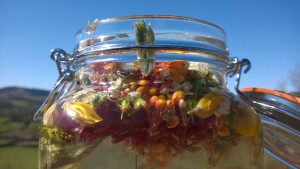
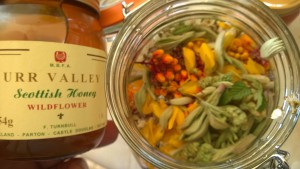
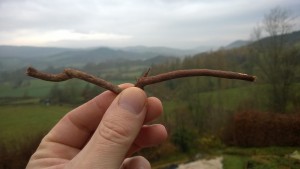
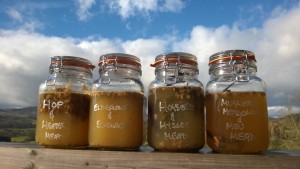
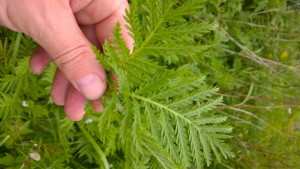
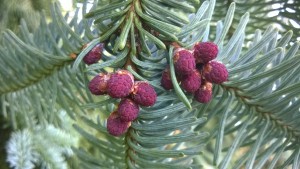

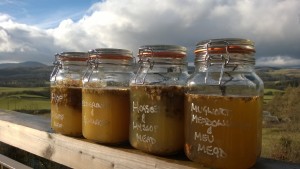
34 Comments
Hi I have to purchase some raw honey, after reading carefully and digesting your beautiful pictures I thought about using honeydew honey? -it is less sweet though and I guess Id like the higher alcohol content -I’d go for adding flavours instead of compromising that haha, Ive never tried it so not sure if by description ‘not as sweet’ is a big deal really. Have you tried making mead with it? I really love this post btw 😀
Hi Fiona, Thanks – glad you like the post. I’ve never heard of honeydew honey, so can’t offer much advice…other than give it a go! The worst that can happen is a sweet gloop, but you may well push back the frontiers of gastronomead! Let me know how you get on. Happy brewing, Mark.
Hi Mark
Where are you getting your honey from? Are there any good sources of cheapish unpasteurised honey you can recommend?
See you at the next SoL Beach Forage…
Hi Carri, I use Galloway Honey, from John Mellis. You can get it in most deli/farm shops around the region, but any decent honey should do.
Cheers,
Mark.
ok, thank you, now I’m totally inspired to start playing with mead…
Yay! Easy peasy meady! 🙂
Looking forward to trying this out. Could you clarify for me – “Keep it at an ambient household temperature without sealing the lid” – Do I l leave the lid of the Kilner fully open for the whole duration, or close it over but without pulling down the clip? Thanks in advance.
Yes. Closed but not airtight is good
Hi Mark
Got the honey and water. Thinking of gorse flower and lemon balm for first batch, but we’ve no heather here – would either elder or hawthorn be ok, or am I likely to poison us if I use these 🙂
Thanks for earlier reply btw!
Hi Mark,
This recipe is ace, and sounds so easy!!
Absolutely love your writing and ideas, can definitely see myself becoming addicted to foraging!
Thank you so much for sharing your knowledge!
Ellie x
Thanks Ellie, have fun!
Mark.
Great ideas and made us chuckle. I’m the tree-hugger, hubby thinks he’s probably the Viking! I’ll put the pickled nasturtium pods down and get out the honey….
Trying this for the first time and have a couple on the go. Noticed some fruit flies hanging around though after a week so have shrouded them with muslin. One however is developing some quite estery smells – pear drops – and maybe a wee bit of white film on the top. Is it headed for ruination / vinegar?
Cheers
I
Not ruination, but possibly vinegar.
White film on top sounds like the possible beginning of a scoby like in kombucha, but I’ve never cultivated a scoby off honey. How did that end up turning out?
Loved this whole journey through the mead making process! Thanks for sharing your passion 🙂
Just a quick question Mark, is ‘Mead’ essentially just fermented honey water, and it’s the herbs that add the flavour? Sounds so simple, i harvested some meadowsweet today and am eyeing up the pot of honey on the shelf… Can’t wait to get me tongue moist with meady magic!
Basically, yes.
I’m thinking of trying sole berry mead but am worried the colour may be off putting. Has anyone tried sloe’s before.
I meant sloe!
Hi Cheryl I’ve been making mead for just a year now and I will be doing a sloe mead sooner or later I haven’t tried any but I’ve heard that those who have say it’s delicious and colour doesn’t mean much in mead as long as it isn’t Brown or green it’ll be golden
I ferment quite a bit of raw honey with Autumn berries to use on stewed apples, pancakes etc. – tiny bit of fresh strained crabapple juice or similar for water content and the rest pure honey covering the berries and ferment for a few weeks. I did some with bullace and sloes mixed with brambles / quince and also bullace/sloes and black hawthorn. They are very tart but exceptionally nice. I reckon sloes in moderation would be a lovely addition to a mead and it would likely benefit from being laid down for a year after fermentation to mellow.
Wait – Meadows are so-called because of their being the source of flowers for Mead?! – well who’d have thought it!!
Hello, you mentioned tutsan in this post. Is it edible? I’ve only ever known it to be poisonous. Excitedly awaiting your response.
It isn’t, to my knowledge, poisonous, but usually only used medicinally. I used a small amount and it was fine, though I don’t know if it actually contributed any flavour.
Ok so my Mugwort Mead has been merrily bubbling for 3 weeks and it tastes sweet, sour and rough. It has been pretty warm (it’s July). Have I made mead vinegar? .
Sounds like you might be well on the way to it! Its not necessarily a bad thing… 😉
Hi! My pal and I have created a wildflower mead jar (mostly bluebell and cherry) and a wood sorrel mead jar. The flower jar has clearly begun fermenting successfully, but the sorrel jar is unquestionably behind it in development. Working theory is that oxalic acid in the sorrel has knocked the pH too low for metabolism to occur as quickly. If that’s the case, do you have any suggestions around working with sorrel meads? Will it “go” if we’re just sufficiently patient, or should be try to adjust pH, or did we just use too much? Thoughts?
Cheers!
I haven’t tried making wild mead yet, but intend to as soon as I get a hold of some decent honey. But I noticed you mentioned tansy. I just had some chopped into scrambled eggs and it was excellent. Cooking took away the bitterness and it reminded me of chervil.
I’ve heard so much about the famous ‘heather ales’ … ever try a heather mead? Did it taste any good?
Hi Erika, I have drunk heather ale (Fraoch), made by the excellent Williams Brothers Brewery, but never made it myself. I have made heather mead, but it isn’t my favourite.
Yay, fir needles spruce and pine i use too…. I wish i had this idea before…. It’s unfortunately a seldom ingredient. Im making a lot of mean, i even pasteurize it and let it mature for years… Ok the oldest i just one year
Hi Mark. I’m new to mead making. Tried an elderberry mead/black mead from the River Cottage book of fermentation. I used an old sterilised pickle jar & closed the lid as the recipe indicated. Before the 2 weeks left to ferment before bottling it had developed white ‘spores’/mild on top. I see you suggest lid on but not tightened – do you think that’ll make the difference?
No, moulds are probably more likely to alight on the ferment if the lid is open. Perhaps you were just unlucky…